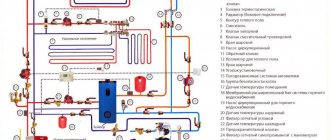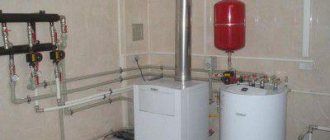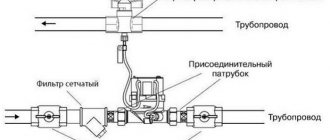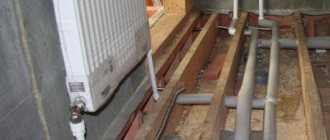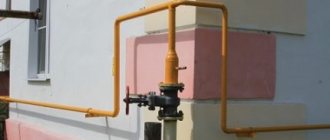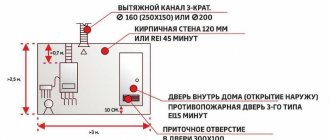Pravozhil.com > Housing and communal services issues > Utilities > Permit for autonomous heating in an apartment building - legal basis, technical requirements
Residents always receive permission for autonomous heating in an apartment building. This is a lengthy and serious procedure when converting living quarters from a central heating system. Any work is performed in strict sequence.
To obtain approval for an autonomous installation, you need to know the design features of the structure. When they begin constructive changes in a building to provide resources, citizens are guided by legal standards. The law and SNiPs do not allow unauthorized intrusion into utility networks.
Reasons for obtaining permission for autonomous heating in an apartment building
Some apartment owners strive to obtain permission for autonomous heating in an apartment building, despite the convenience of the central system.
How to install individual heating in an apartment building?
An incomplete list of criteria that influence the decisions of residential property owners:
- limited thermal regime;
- complete dependence on a common boiler;
- increase in tariffs.
Devices in a separate room fail, but the entire array is disabled. The heating season begins at a specific period, and winter has not obeyed the production schedule, the rooms are not comfortable from the cold.
In spring, everything is the other way around; the batteries glow with heat during warm weather. Failures, uneven temperature conditions, disconnection of the building from the heating system - do not reduce payments and cause dissatisfaction among residents. They come to the conclusion that an autonomous system is the only way to economically heat an apartment.
Requirements and standards for heating an apartment
A comfortable temperature for the life of each person is determined by a number of factors. Too high, as well as too low a temperature, negatively affects the condition of the human body. Therefore, the temperature at which the body does not turn on its cooling and heating mechanisms is considered normal. These factors include:
- intensity of human activity;
- season;
- daily temperature fluctuations.
People who work in hot shops or athletes who train will not freeze even at low indoor temperatures. While office workers need warmer conditions.
Also, each person’s body adapts to general climatic conditions. Therefore, for a comfortable existence in winter, it is enough to heat the room to +19...+22°C, and in summer - to +22...+25°C.
According to the rules and regulations, in residential premises the minimum temperature threshold should not fall below +18°C. Heating standards for apartments are easier to develop than for work areas, because the activity of people at home is lower than in production. The permissible temperature fluctuations for each room are different:
- kitchen: the optimal temperature is considered to be +19...+21°C, and acceptable - from +18...+26°C;
- toilet: +19…+21°С; +18…+26°С;
- bathroom: +19…+21°С; +18…+24°С;
- corridor: +18…+20°С; +16…+24°С;
- pantry: +16…+18°С; +12…+18°С.
It has been proven that during sleep the body does not need an additional source of heating, therefore, according to GOST, it is allowed to lower the temperature in residential premises by 3°C from 0 to 5 am.
Positive factors
The owner must evaluate all the advantages of the reconstruction and find out the negative aspects of a radical replacement of the system. Positive indicators that the owner receives:
- The apartment can be heated at any cool time, regardless of the season. The central system is turned on and off according to the standards established in the region, based on the average temperature values by season. Often this does not coincide with weather conditions, which are unstable with large fluctuations during the day.
- With autonomy they regulate the temperature in the rooms; central heating does not keep track of energy consumption according to their locations and insulation. In a house, the apartment can be located inside or be a corner one, which is blown by external winter air currents. In the management company, costs for resources are distributed so that there are no losses; accruals are made in the same amount per 1 sq.m. The owner pays according to the size of the occupied space. Apartments, like the rooms in them, may differ from each other in location and amount of heat consumed. With autonomous heating, every factor is taken into account to create a comfortable microclimate and save money.
- An individual heating system can be easily set to a specific mode, so as not to completely heat, but to maintain the temperature in the absence of residents. When the apartment is occupied, the automation heats the rooms to optimal parameters. Technical devices regulate heating remotely; when installing programs, the equipment reacts to worsening weather, they can be controlled.
- Lower energy consumption reduces operating costs but increases efficiency.
- If you install a double-circuit boiler, it will create hot water supply bypassing the central supply. The apartment will be exempt from general preventive maintenance in the house. The owner will pay for the actual consumption of resources recorded by the meter.
What material to choose so that the replacement of pipes in the apartment is successful
The most common pipes for cold and hot water today are made of metal-plastic, polypropylene, copper and galvanized steel. Let's take a closer look at the pros and cons of each material.
Metal-plastic pipes
Metal-plastic pipes have the form of a structure in which there are four layers - cross-linked polyethylene, an aluminum layer, the thickness of which is 0.4 mm (performs a reinforcing function), a layer of glue and wear-resistant plastic on the outside.
These communications are universal. Based on the name, such a pipe combines a layer of both plastic and metal. Thus, the outer layer is not subject to corrosion and has a long service life. The inner layer makes the pipe reliable, yet flexible and durable. The developers of metal-plastic communications managed to eliminate the problem characteristic of plastic - instability to high pressure and temperatures.
Advantages of metal-plastic pipes:
- corrosion resistance;
- ease of installation;
- the outer layer of the pipe does not conduct current;
- many different fittings.
The disadvantages of such pipes are:
the need for constant tightening.
Read material on the topic: Metal-plastic pipes: types, sizes, operation
Polypropylene pipes
If you are replacing pipes in your apartment with polypropylene ones, the price of the repair will definitely please you. The cost of such communications today is the most optimal in terms of price and quality ratio. You will also get high performance characteristics of pipes made from this material. This type of communication can be called the most utilitarian and practical.
Unlike pipes made of PVC or polyethylene, polypropylene pipes are not so susceptible to temperature changes, especially low ones. Polypropylene can also cope with hot water, but it is necessary to prevent exceeding the threshold values.
Polypropylene pipes are smooth on the outside, have high strength and are resistant to deformation. The thickness of their walls can be up to 8 mm, and inside they are often reinforced with aluminum or fiberglass.
By replacing the pipes in your apartment with polypropylene ones, you will receive a pipeline with a very long shelf life, because... these communications are not afraid of exposure to water and can be used in adverse conditions.
So, the advantages of polypropylene pipes include:
- high throughput;
- ease of installation;
- maximum tightness of joints;
- resistance to mechanical damage;
- low cost.
The disadvantages of these pipes are:
- permanent connections;
- limited operating temperatures.
Read material on the topic: Wholesale sale of polypropylene pipes at competitive prices
Copper pipes
Copper pipes are a classic that have proven themselves over decades of excellent work. Since pipes began to be made from this material a very long time ago, there are houses with copper pipelines whose service life is approaching a hundred years. Despite such impressive characteristics, these communications are far from the most affordable price.
The durability of copper pipes exceeds that of even polymer products. At the same time, they have good flexibility and a very wide operating temperature range. In addition, copper also has advantages from an aesthetic point of view.
In addition to the price, which is a significant disadvantage of these pipes, the disadvantages include poor resistance to deformation. This, of course, makes installation easier (you can bend the pipe to any position), but it also reduces the overall safety of the entire site.
Pros of copper pipes:
- longest service life;
- ability to work at any temperature;
- aesthetically pleasing appearance;
- corrosion resistance.
Disadvantages of copper pipes:
- price;
- difficult installation;
- low mechanical strength.
Galvanized steel pipes
Galvanized steel pipes remain popular. By replacing communications in an apartment with this material, you will receive good moisture resistance, as well as high reliability and durability. At one time, galvanized pipes replaced ordinary steel ones.
Advantages of galvanized steel pipes:
- maximum mechanical strength - they are perfect for replacing a riser in an apartment;
- corrosion resistance;
- high throughput - due to galvanization, the pipe does not overgrow or become covered with plaque.
Disadvantages of these pipes:
- relatively high price;
- complex installation.
Negative points
Individual heating requires a complex process of documentation and construction work with separate material costs.
What is the complexity of the procedure:
- The work is carried out legally and all technical requirements are met. Carrying out unauthorized reconstruction will not exempt you from utility bills; installing equipment without permission will result in administrative penalties including dismantling of the devices.
- You need to obtain permits, disconnect from central communications, and develop a project.
- Installation work belongs to a complex category; it is performed by specialists with the necessary skills.
- Registration of documents, purchase of equipment, installation - require specific costs.
When the owner goes through all the stages of arranging autonomous heating, he becomes responsible for its prevention and the safe operation of all installations.
Inspectors from specialized organizations will visit the apartment. In the event of an accident, officials will be held accountable by law for each violation.
Which organization do you contact first?
Residents of an apartment building are saved from interruptions in central heating in winter by installing individual units. In practice, in addition to expensive services, they face bureaucratic obstacles.
Local authorities are competent to make this level of decisions, but do not always reach a satisfactory verdict on individual apartments.
To disconnect from the general system and connect to autonomy, you need to contact a special interdepartmental commission, which is created by the local executive body.
Application procedure, the application is submitted to the regional administration, then:
- the commission will consider the issue;
- decides;
- draw up a protocol;
- will communicate the information to the interested party.
How is the transfer to individual heating carried out?
A positive decision opens up the opportunity to obtain technical conditions to begin developing the project.
This document contains technical calculations for the reconstruction of heat supply with the relocation of risers, thermal insulation and installation of basic elements.
After the design documentation is ready, approval is required from enterprises associated with the connection to the heating system according to technical conditions.
When the project is approved, they begin purchasing parts and sign a contract for the installation of equipment. After completing all the work, you need to come to the organization responsible for the supply of energy raw materials to create a new agreement on heat supply.
Builders are developing new generation projects for multi-apartment buildings, where an autonomous system is provided entirely for the house or apartments.
In cottages and country buildings there are no restrictions on heating autonomy. Owners enter into contracts with specialized design organizations that perform all calculations for a complete design for heating the house.
Modernization of the ventilation system
As you know, the most common way to organize air circulation in apartment buildings is natural ventilation. Air is removed through exhaust ducts located in kitchens and bathrooms. The flow of fresh air from the street is organized through natural leaks in windows and doors.
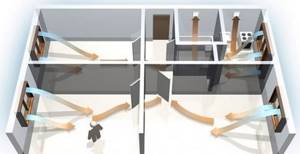
When replacing old windows with energy-efficient and sealed ones, the problem of heat loss is solved, but a new one appears: a sharp decrease in the supply of fresh air. This problem is solved by modernizing the ventilation system, namely, by installing ventilation with controlled air flow. In practice, this is solved by installing supply valves, windows with built-in hygroscopic fans, or installations for forced supply of fresh air into rooms.
How many approvals do you need to collect?
For individual heating, the apartment needs to be redesigned. Both the destruction of walls and partitions and their construction consist of a labor-intensive process.
It will take a long time to receive each completed paper. It is necessary to take into account installation work and the purchase of materials, so reconstruction begins with the preparatory stages:
- determined with the collection of a documentary package;
- develop a project;
- purchase equipment;
- install an autonomous system.
What legislation regulates individual heating in an apartment building? The regulation for any redevelopment is the Housing Code of the Russian Federation, Article 26.
The reconstruction of residential premises is carried out according to technical requirements; each stage of work must be agreed with the local government. To contact the regional authority, you need to collect documents that will serve as an appendix to the main application.
General documentary support for the submitted application, filled out according to the standard form:
- title documentation - this can be a certificate of ownership, transfer of an apartment by inheritance, a purchase and sale agreement;
- photocopy of technical passport;
- redevelopment of an apartment in the project;
- information about all registered persons in the residential area;
- written notarial consent of each registered person;
- confirmation that the building is not an architectural monument.
When the administration receives a documentary kit, they issue a receipt of its receipt with a detailed list.
The papers will be sent to the commission for approval, the body will review and make a decision within a month. The document will be sent to the applicant for review.
Redevelopment may be refused if it worsens the condition of the house or threatens the safety of residents.
Project documentation for autonomous heating is coordinated with authorized organizations from the field of gas and heat supply.
To disconnect the heating circuit in an apartment from the general system, you need to obtain permission from the city or regional heating networks.
Specialists of this level will agree to an agreement provided that the installations do not disrupt the functionality of the building's utilities and equipment.
Only a security threat can lead to the refusal of a request for heating autonomy. Applications for an individual heating system are accepted by the housing management organization.
Actions consist of the following steps:
- receive a consent letter;
- contact the gas service;
- receive technical specifications;
- take apartment property documents;
- order a project;
- purchase equipment that meets the specifications.
SNiP41-01-2003 contains the basic requirements for heating and ventilation devices. You can be exempt from registration by concluding an agreement with an organization that provides such services.
On what basis are they refusing?
Local executive authorities do not always satisfy requests for the conversion of apartments with heating systems. In judicial practice there are reasonable responses to refusals in proceedings in this area.
Citizens are turning to district courts with statements of claim in which they complain about the decisions of the construction and major repairs departments refusing to renovate and remodel apartments.
Residents did not want to be connected to central heating; they considered it more economical to use an autonomous gas boiler.
The reason for the refusal is in the design of the houses; it does not provide for such heat supply. The building diagram shows that it is impossible to disconnect a separate apartment and completely solve the issues of technical support for individual places in the house with general building communications that are developed in the project.
Installation of new pipes and heating radiators using gas welding
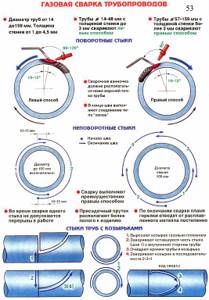
To replace steel pipes, it is best to use welding machines. Threaded connections are less reliable and may not withstand pressure surges typical of central heating.
Replacing heat supply batteries during the heating season is characterized by a high quality connection. The technology consists of heating the workpieces to the melting temperature and diffusion joining the metal in the weld.
To self-replace heat supply batteries using gas welding, you will need to perform the following steps:
- Preparatory stage. The site of the future weld is protected, the oxide layer, paint and fat layer are removed.
- The parts are connected and, with the help of burner gases, melting occurs in a certain area.
- A special wire is used as solder. Without it, replacing heat supply batteries with gas welding is impossible. When melted, it fills the joints and forms a high-quality weld. The type of wire depends on the material used to make the pipes.
- After forming a seam when replacing heating pipes in an apartment, scale is removed and the tightness is checked.
If necessary, an additional layer of welding seam is applied. But experts do not recommend doing this. Excessive temperature exposure to pipes when replacing a heating battery with your own hands can affect the characteristics of the metal - it will become more fragile.
Replacing heat supply radiators with gas welding and forming a seam can be done in different positions - horizontal or vertical. It all depends on the brand of wire.
Obtaining a permit depending on the type of energy carrier
In 2012, Government Decree No. 307 was issued, which considered the legal procedure for connecting devices to supply heat to apartment buildings.
The legal order establishes requirements for devices and prohibitions for installing equipment that does not meet technical conditions.
For example, gas boilers must meet the requirements:
- the combustion chamber is hermetically sealed;
- the fuel supply is automatically turned off;
- the carrier temperature does not exceed 90 degrees, with a pressure of up to 1 MPa.
When submitting an application for permission to disconnect from the general heating supply, indicate the type of boiler: single-circuit or double-circuit. Permits are obtained for both heating and hot water. The owner chooses a wall-mounted or floor-mounted boiler design.
The owner of the apartment will have to arrange a room that meets the following conditions:
- the room should not be residential;
- 4 sq.m. - square;
- 8 m – width of the entrance door;
- a window opening facing the street was cut through;
- equipped with a chimney;
- a ventilation structure has been installed.
Upon acceptance, when it gives consent to commissioning, it checks the equipment and premises.
They must meet the requirements for ensuring the safety of the residents of the house. Electric heating does not have such strict installation requirements. They install devices in any convenient place.
This equipment does not require separate ventilation to remove combustion products, and power points are located in each room.
The layout is approved by Energonadzor, the organization’s employees calculate additional sources, and allocate the power line of the required power.
Local heating networks and energy companies will provide their list of necessary documentation for connecting the boiler. Each district has established local requirements for equipment and installation. They are directly responsible to the executive branch and the law if an emergency occurs.
Electric heating can be using:
- units in which there is a normal pipe layout where the coolant circulates;
- direct heating devices, electrical systems, convectors, heaters.
When coolant is used, the piping to the radiators is not touched. They are connected to electric boilers, from which the coolant is heated instead of heating heating lines. Such units operate in an automatic heating system.
When heated, coolants from water or antifreeze pass through:
- boiler;
- heating circuit;
- radiators;
- cooling of the liquid;
- return and repetition of the cycle.
Gas equipment cannot be installed in any utility room. For an electric boiler, installation of the location is not important; consider convenient wiring for the power line with the heating circuit. Kitchens and bathrooms are the most comfortable rooms for laying pipes on wall surfaces.
About the legal possibility of disconnecting from centralized heating services and installing autonomous (individual) heating in an apartment building in the following video:
See also Phone numbers for consultation April 11, 2021 Yulia Yuryevna 899
Share this post
Re-equipment of thermal units
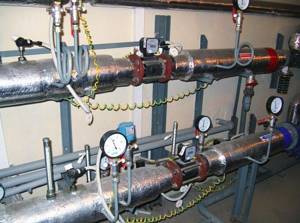
Modernization of these facilities is a rather complex and expensive process. Which includes the following changes:
- Replacement of the elevator unit of the heating system with an automated one. If the house is connected to the heating main according to an independent circuit, an automated individual heating point is installed; when using dependent, a scheme with a pump mixture is used. Depending on the scheme used, all equipment must be weather-sensitive and automatically stabilize the pressure in the CO by regulating the supply of coolant.
Important! Replacing an outdated elevator unit with an economizer will not make it possible to use thermostats for heating radiators and balancing valves. The elevator simply “will not handle” the additional hydraulic resistance, which will inevitably increase when using these devices.
- Replacement of old heat exchangers with energy efficient ones.
- Elimination of CO leaks and replacement of shut-off valves.

